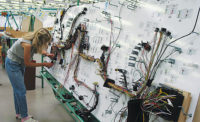In describing U.S. consumers on his 1972 comedy recording, Class Clown, George Carlin was almost prophetic about the state of U.S. manufacturing today. The typical consumer, he noted, does not merely want an inhaler with a nasal decongestant. He wants an inhaler for his left nostril imprinted with his state's motto.
Carlin may have been riffing on crass commercialism at the time, but his gibe goes to the heart of an issue facing a growing number of assembly plants today: Manufacturing is shifting away from high-volume, low-mix production to high-mix, low-volume production.
According to ASSEMBLY's annual Capital Equipment Spending Survey, there's little doubt that fewer manufacturers are performing high-volume assembly today than there were 8 years ago. In 1996, 25 percent of plants produced more than 1 million assemblies annually. In 2004, only 19 percent did so. At the same time, the number of low-volume manufacturers is increasing. In 1996, 24 percent of plants produced less than 1,000 assemblies annually. In 2004, 35 percent did so.
As production volumes have decreased, production variety has increased. U.S. manufacturers are assembling a greater mix of products than ever before. In 1996, 16 percent of plants assembled more than 10 different product types annually. In 2004, 23 percent did so.
The main reason for this shift, as Carlin alluded to, is that consumers increasingly want products tailored to their particular needs. Consider the humble refrigerator. It has one job: keep food cold. Yet Whirlpool Corp. (Benton Harbor, MI) offers no less than 57 models of refrigerator, differentiated by configuration, features, finish, height, width and, of course, price.
"Customers are looking for more variety. They don't want the same old thing," explains Kevin Duggan, president of Duggan & Associates (West Warwick, RI), a consulting firm specializing in lean manufacturing.
Outsourcing also shares the blame for the increase in high-mix, low-volume production. High-volume production has largely been taken over by foreign manufacturers, while low-volume production has remained in the United States.
"You can't get the turnaround time from offshore manufacturers. They're just not geared for that," says Wes Price, CEO of BCP Trilogy (Placentia, CA), an electronics manufacturing service (EMS) provider. "Offshore manufacturers like to set up and run. They have quite an investment in capital equipment, and they don't like to take their machines down, because they have to amortize that cost. As a matter of fact, we often subcontract low-volume jobs for a Latin American contract manufacturer."
Another reason for the shift to high-mix, low-volume production is business volatility. Manufacturers, especially those that supply OEMs, can no longer afford to be tied to one major customer or industry.
"The trick is to supply a lot of different parts to a lot of different customers, rather than a lot of one part to one customer," says Duggan, author of the book Creating Mixed Model Value Streams: Practical Lean Techniques for Building on Demand (Productivity Press, New York, 2002). "I know one machine shop that supplies a high-volume product to a large aerospace conglomerate. Every time that big company hiccupped, the machine shop would stall and almost go out of business."
According to Duggan, the machine shop would be better off with a larger, more diverse customer base. By learning to reduce setup times and build a combination of products at the same time, the shop will find that it needs less lead time to produce an order. When lead times shrink, capacity opens up and there's less chance for things to go wrong.
"High-mix, low-volume assembly gives you the ability to react to changes in the marketplace," says Duggan. "When you build in big batches, you don't have that ability."
That's the good news. The bad news is that product variety and fast response times can increase the costs associated with material handling, setup, test and other processes. To excel at high-mix, low-volume assembly, manufacturers must be adroit at scheduling, inventory management, mistake-proofing and process control.
Different Paradigms
The strategies for high-mix, low-volume assembly are often opposite from those for high-volume, low-mix production. For example, high-volume manufacturers win business based primarily on the cost and quality of their products, says R. Michael Mahoney, president of Manufacturing Decision Analysis LLC (Loveland, CO). On-time delivery and customer responsiveness are qualifiers for business, but they're not the most important considerations.
In contrast, high-mix manufacturers earn business based primarily on how quickly they can deliver exactly what their customers want. Cost and quality are qualifiers for business, but they're not the most important considerations. "Customers expect to pay a premium to get what they want," says Mahoney, author of the book High-Mix, Low-Volume Assembly (Prentice-Hall, Englewood Cliffs, NJ, 1997).
Similarly, while strategies like just-in-time manufacturing and demand-flow technology are important to high-volume, low-mix production, they are inappropriate for high-mix, low-volume assembly. "That's because it's impossible to balance capacity in a high-mix, low-volume manufacturing facility, where the work times for each product are unequal," says Mahoney, a certified fellow in production and inventory management. "Some manufacturers try to balance capacity by shifting people here and there. However, that fails because not everyone has the same level of competence. Quality suffers. Eventually, your factory becomes more focused on moving people than moving product."
To avoid the problem of unequal work times, assemblers must learn to schedule production effectively. Often, production managers simply assemble orders in the sequence in which they are received. But, says Mahoney, that's usually the worst possible solution. Invariably, one process step for a particular product requires significantly more time than the steps for all other products in the mix. This creates a bottleneck that stalls upstream processes and starves downstream ones. By the time engineers eliminate the bottleneck, the next product in the queue is ready for production, and the constraint moves to another part of the line.
"Incompetent managers will blame poor manufacturing performance on an unfavorable order mix," says Mahoney. "But, you have control over how those orders go through your factory. To launch them ad hoc introduces randomness into your system. You're constantly turning constraints on and off."
A better solution is to divide each incoming order into batches that can all be assembled in roughly the same amount of time, a method Mahoney calls multiple constraint synchronization. To accomplish this, engineers will need to know how much time is needed to complete each step in the assembly process for each product. The longest process step among all the products will then be the lowest common denominator with which to develop a balanced production schedule.
For example, say a factory must assemble two products, A and B. Each product needs the same two processing steps, C and D. Product A requires 2 seconds at Step C and 1 second at Step D, while Product B spends 1 second at Step C and 4 seconds at Step D. To avoid bottlenecks at either process step, engineers should stagger production: two As, one B, two As, one B, etc.
The goal is to schedule production so that the entire system is "uniformly constrained at the same time," says Mahoney.
Mastering Setup
Regardless of how assemblers schedule high-mix production, reducing setup time is critical. In this regard, assemblers can learn from their brethren in the machine shop and press room by applying techniques for single-minute exchange of dies (SMED) to assembly equipment. Operators should stage the next job while the current job is running. Assemblers should simplify fixtures and use subplates on machine tables. Quick-connects should be used to secure fixtures instead of fasteners, and all the tools, fixtures and parts necessary for changeover should be located on or near the machine.
Simple actions, such as preparing a changeover checklist, can make a big difference, and cost nothing to implement. "Think of a NASCAR race," says Duggan. "When a car pulls into the pit, the mechanic never goes looking for a wrench. Yet, how many times does an operator stop a machine and go looking for something?"
EMS providers know these lessons well. Solder pallets, preloaded banks of reeled components, and reversible holders for work instructions and inventory are just a few of the tricks of the trade at EMS provider Sigmatron International (Elk Grove Village, IL), says Steve McNulty, the company's vice president of sales.
Mistake-proofing and strict process control are inherent parts of any program to reduce setup time. Quick changeovers make little difference if an assembly machine requires a lengthy test run or the first assemblies produced with a new setup are defective.
"Process control is paramount to achieving high first-pass yields in any environment," says McNulty. "Tools such as SPC [statistical process control] alert the operator to potential changes in the process causing it to become out of control. These tools are quite effective in a high-volume environment.
"In a low-volume environment, there may not be enough...data to make SPC feasible. In this case, detailed work instructions, automatic optical inspection and visual inspection combine to ensure high first-pass yields. Additionally, design reviews, including design for manufacturability and design for test, can help ensure that the design is optimized for that particular facility and manufacturing process, prior to beginning full production."
Duggan adds that no assembler should tolerate a process with an inherent failure rate, regardless of production volume. "If you're worried that you can't do a five-piece run because the first four are always bad, that's where you need to focus your kaizen efforts," he says.
Standard work is critical to both reducing setup time and improving first-pass yield, says BCP Trilogy's Price. "You must have standard setup procedures for each machine," he explains. "In our case, we keep that information online, so it's very easy for the operators to access. You don't have to reinvent the wheel with every new job."
Duggan agrees. He urges assemblers to make changeovers as simple as possible. "Instead of setting dials and gauges, think square pegs and round holes," he says. "By standardizing setup, everyone should be able to set up the machine the same way, regardless of their skill level."
Sometimes, the best setup is no setup at all. "High-mix manufacturers tend to think that flexibility is the key to their success," explains Duggan, "so they want the ability to produce the same part on any machine on the floor.
"A better solution is to analyze part demand, machine loads and part designs, and then dedicate each machine to specific families of parts. Once you know that a machine will only be running parts A, B and C, you can custom-make a fixture just for those three parts. Changeover simply becomes a matter of rotating the fixture."


